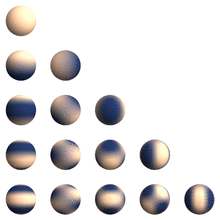
Gravity of Mars
The gravity of Mars is a natural phenomenon, due to the law of gravity, or gravitation, by which all things with mass around the planet Mars are brought towards it. It is weaker than Earth's gravity due to the planet's smaller mass. The average gravitational acceleration on Mars is 3.72076 ms −2 (about 38% of that of Earth ) and it varies laterally. [1] In general, topography-controlled isostasy drives the short wavelength free-air gravity anomalies . [2] At the same time, convective flow and finite strength of the mantle lead to long-wavelength planetary-scale free-air gravity anomalies over the entire planet. [3] [4] Variation in crustal thickness, magmatic and volcanic activities, impact-induced Moho -uplift, seasonal variation of polar ice caps, atmospheric mass variation and variation of porosity of the crust could also correlate to the lateral variations. [5] [6] [7] [8] [9] Over the years models consisting of an increasing but limited number of spherical harmonics have been produced. Maps produced have included free-air gravity anomaly , Bouguer gravity anomaly , and crustal thickness. In some areas of Mars there is a correlation between gravity anomalies and topography. Given the known topography, higher resolution gravity field can be inferred. Tidal deformation of Mars by the Sun or Phobos can be measured by its gravity. This reveals how stiff the interior is, and shows that the core is partially liquid. The study of surface gravity of Mars can therefore yield information about different features and provide beneficial information for future landing projects.
Page Revisions
| Year | Metadata | Sections | Top Words | First Paragraph |
| 2018 |
210644 characters 21 sections 62 paragraphs 14 images 241 internal links 83 external links |
4. Time-variable gravity field |
gravity 0.300 bouguer 0.298 anomalies 0.287 crustal 0.250 anomaly 0.232 displaystyle 0.220 tracking 0.161 frac 0.132 harmonic 0.126 correlation 0.123 topography 0.118 c_ 0.118 density 0.115 crust 0.112 thickness 0.104 |
The gravity of Mars is a natural phenomenon, due to the law of gravity, or gravitation, by which all things with mass around the planet Mars are brought towards it. It is weaker than Earth's gravity due to the planet's smaller mass. The average gravitational acceleration on Mars is 3.72076 ms −2 (about 38% of that of Earth ) and it varies laterally. [1] In general, topography-controlled isostasy drives the short wavelength free-air gravity anomalies . [2] At the same time, convective flow and finite strength of the mantle lead to long-wavelength planetary-scale free-air gravity anomalies over the entire planet. [3] [4] Variation in crustal thickness, magmatic and volcanic activities, impact-induced Moho -uplift, seasonal variation of polar ice caps, atmospheric mass variation and variation of porosity of the crust could also correlate to the lateral variations. [5] [6] [7] [8] [9] Over the years models consisting of an increasing but limited number of spherical harmonics have been produced. Maps produced have included free-air gravity anomaly , Bouguer gravity anomaly , and crustal thickness. In some areas of Mars there is a correlation between gravity anomalies and topography. Given the known topography, higher resolution gravity field can be inferred. Tidal deformation of Mars by the Sun or Phobos can be measured by its gravity. This reveals how stiff the interior is, and shows that the core is partially liquid. The study of surface gravity of Mars can therefore yield information about different features and provide beneficial information for future landing projects. |
| 2017 |
213348 characters 21 sections 62 paragraphs 14 images 240 internal links 99 external links |
4. Time-variable gravity field |
bouguer 0.299 gravity 0.296 anomalies 0.288 crustal 0.251 anomaly 0.233 displaystyle 0.221 tracking 0.161 frac 0.132 harmonic 0.126 correlation 0.123 topography 0.119 c_ 0.118 density 0.115 crust 0.112 thickness 0.104 |
The gravity of Mars is a natural phenomenon by which all things with mass around Mars are brought towards it. It is weaker than Earth's gravity owing to the planet's smaller mass. The average gravitational acceleration on Mars is 3.72076 ms −2 (about 38% of that of Earth ) and it varies laterally. [1] In general, topography-controlled isostasy drives the short wavelength free-air gravity anomalies . [2] At the same time, convective flow and finite strength of the mantle lead to long-wavelength planetary-scale free-air gravity anomalies over the entire planet. [3] [4] Variation in crustal thickness, magmatic and volcanic activities, impact-induced Moho -uplift, seasonal variation of polar ice caps, atmospheric mass variation and variation of porosity of the crust could also correlate to the lateral variations. [5] [6] [7] [8] [9] Over the years models consisting of an increasing but limited number of spherical harmonics have been produced. Maps produced have included free-air gravity anomaly , Bouguer gravity anomaly , and crustal thickness. In some areas of Mars there is a correlation between gravity anomalies and topography. Given the known topography, higher resolution gravity field can be inferred. Tidal deformation of Mars by the Sun or Phobos can be measured by its gravity. This reveals how stiff the interior is, and shows that the core is partially liquid. The study of surface gravity of Mars can therefore yield information about different features and provide beneficial information for future landing projects. |